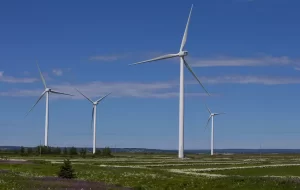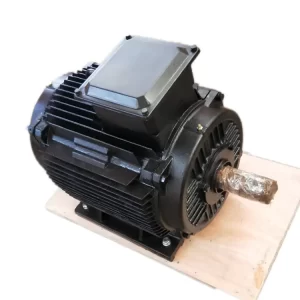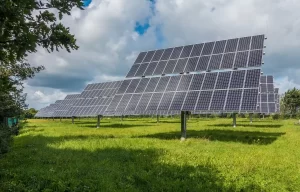
Permanent Magnet Generators (PMG) are one form of electric generator that uses permanent magnets to convert mechanical energy into electrical energy. PMGs use ferrites or rare-earth magnets which have an inherent magnetic field, unlike the electromagnetic coils of conventional generators. This unique configuration provides a more compact design and considerable energy production; therefore PMGs are well-suited for renewable energy, including wind, water & solar power.
A Permanent Magnet Generator consists of a rotor, stator, and supportive frame. The rotor contains the permanent magnets that generate a magnetic field, while the stator contains windings of conductive material where we convert the magnetic energy associated with the rotor into electrical energy by electromagnetic induction. When the rotor spins — either from wind or water currents — it creates a changing magnetic field which induces an electrical current in the stator’s windings. It is designed in a way to generate maximum energy while losing minimum energy. In addition, improvements like finite element analysis for generator design have aided performance, especially in smaller designs that solved the low startup torque problem.
Permanent Magnet Generators have been developed and used since the early 20th century, but many improvements have been made in the last decades. New materials science has brought us high-strength magnets that are far superior to those in earlier systems. The use of computer-aided design techniques has also contributed to optimizing generator efficiency and reliability. In addition, industries looking for eco-friendly solutions are further fastening the adoption of PMGs on account of increasing focus on renewable energy sources. Innovative companies like Qingdao Enneng Motor Co., Ltd are leading the way with customizable PMG solutions and continuously advancing their technology to keep up with market demands.
The main benefit of Permanent Magnet Generators is they have high efficiency. PMGs, with more than 95% efficiency, convert energy least possibly; i.e., without serious loss of energy. For renewable energy installations that need every last watt, this level of performance is vital. In addition, PMGs are efficient across a wide range of speeds, and therefore suitable for different systems—from micro-hydropower to large wind farm applications. Their low-wind-capacity performance increases their reliability and usefulness when environmental conditions are less than ideal.
Reduction in Maintenance Cost: One of the most important advantages associated with Permanent Magnet Generators is that they reduce maintenance costs. PMG usually does away with brushes and slip rings, as these parts in ordinary generators are generally responsible for significant wear and tear. Finally, this and the absence of gears in many PMG designs lead to diminished chances of mechanical failure which reduces maintenance schedule and cost. According to Denning, its generators are designed for durability and maintenance-free operation, allowing operators to allocate these resources toward more focused areas of their business.
Permanent Magnet Generators feature a more rugged construction combined with advanced materials and, as such, they tend to be significantly more robust. Due to H-class insulation, vacuum pressure impregnation, and other features that allow them to perform well under high humidity, temperature, or corrosion environment PMGs operate in harsh environmental conditions. PMGs have existed for decades and have been successfully adopted, with limited lag and failure rates, in industries such as petrochemicals and mining. It also reduces the risk of operations and supports the transition to sustainable energy solutions because renewable energy applications need a stable power reserve.

Permanent Magnet Generators (PMGs) are rapidly becoming an integral part of modern wind turbines and ushering in meaningful developments concerning wind energy conversion systems. These generators use permanent magnets which remove the complex electromagnetic windings that exist in conventional generators This simplifies the turbine, improving efficiency during operation and increasing energy capture at lower wind speeds. Easy to construct, the compactness of PMGs also means a smaller footprint for installations of wind turbines which makes them highly suitable for onshore as well as offshore Wind Farms.
Wind power generation efficiency has significantly increased with the use of PMGs. These generators can deliver operational efficiencies that are significantly higher than conventional systems mainly because of their ability to operate over a wider bandwidth of wind speeds. Additionally, the type of design that a PMG uses generally has very little energy lost from friction and heat. Similarly, increases in energy conversion efficiency will not only optimize the power output of a single wind turbine but also maximize the utilization of available resources thus maximizing the sustainability impact within a wind energy project [18][19].
Permanent Magnet Generators are used for both small-scale and large-scale hydropower systems. They cater to different operating requirements, ranging from micro-grid applications up to large-scale hydropower projects. PMG equipment can be installed directly into existing hydro infrastructure, making it easier for operators to modernize and boost the overall efficiency of their systems. PMGs are even more versatile and can capitalize on low-head water streams; therefore, they have the flexibility to address varying energy generation demands while minimizing ecological consequences [30].
Although the generator’s application must be determined, the benefits of replacing traditional generators with Permanent Magnet Generators have been proven with numerous studies related to hydropower usage. PMG enables higher efficiency, less maintenance, and better operating reliability in the life cycle of a faster. And, traditional generators with their moving parts need more complex maintenance procedures and this can lead to longer downtimes or operational costs in the long run. On the other hand, fewer mechanical components in PMGs result in reduced risk of mechanical failure and thus lower overall operating costs and steady power generation.
Permanent Magnet Generators (PMG or PM) are becoming more common in the solar energy world, particularly with hybrid solar PV and other renewable energy installations. While solar systems provide clean energy, PMGs act as the auxiliary power supply system and ensure functionality during low sun irradiation periods. The compact design allows easy integration into the solar ecosystem, optimizing energy generation. Additionally, the integration of PMGs and solar energy systems can facilitate more effective power management to balance energy generation with demand.

This integration of Permanent Magnet Generators into solar power systems increases overall performance. PMGs offer higher yields in terms of energy by enabling their well-known high reliability and efficiency while requiring low operation & maintenance costs which allows for more cost-effective solar plants. Moreover, PMGs are usually equipped with close-loop advanced controls making it easy for intelligent grid integration to optimize the energy flow. With the increasing adoption of renewable energy solutions, the potential for PMGs to work in tandem with solar technology embodies their role as key enablers of sustainable energy opportunities.
Qingdao Enneng Motor Co., Ltd. is a leading manufacturer and supplier in the field of advanced electric motors and generators, permanent magnet generators, and so on. The company strives to provide flexible solutions fit for the changing requirements of numerous industries including renewable energy, petrochemical, and marine applications. Qingdao Enneng has established itself with consistent quality and performance as a reliable partner for customers in search of energy solutions.
Qingdao Enneng also designs advanced Permanent Magnet Generators for use in hydropower as well (in addition to the wind energy they are known to supply). This type of generator is a second and third scale for both large and small hydropower plants. The design innovations incorporated in these PMGs improve the reliability and efficiency of your operation. Every hydropower generator is tailor-made for each project, thanks to Qingdao Enneng whose dedication to customization makes all that possible—to successful energy generation minus a heavy environmental stamp.
As a specialist in Permanent Magnet Generators, Qingdao Enneng Motor Co., Ltd. maintains its position at the forefront of renewable energy by providing products that optimize system efficiency while being more sustainable. Then energetic landscape needed to keep up with the constant quick happens of the need for customer-oriented solutions that renew the able energy market. The company continues to adapt to the changing needs of the renewable energy sector whilst focusing on customer-focused solutions.